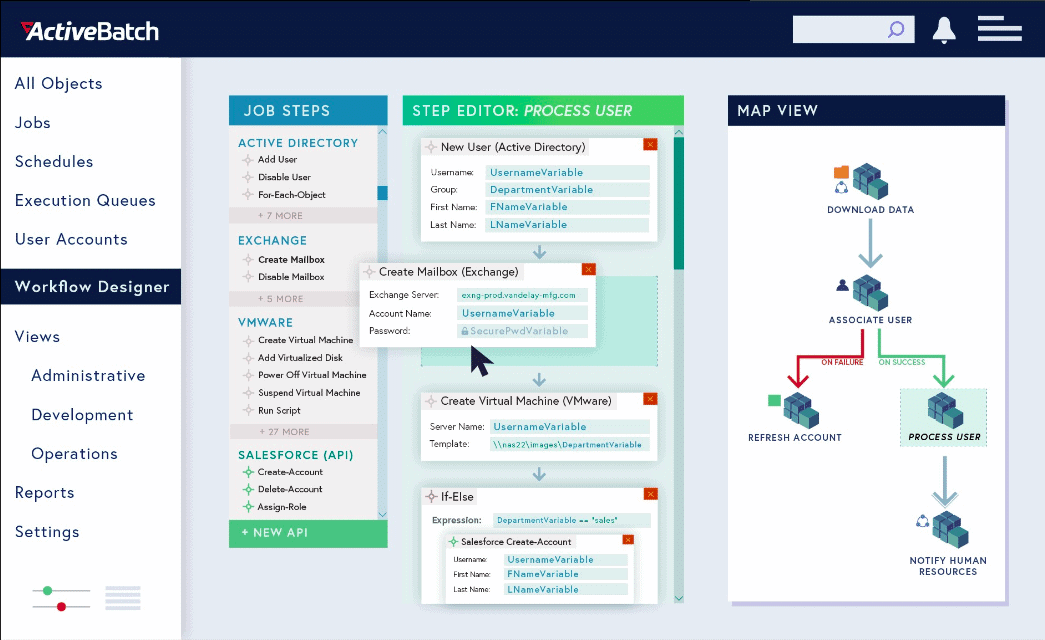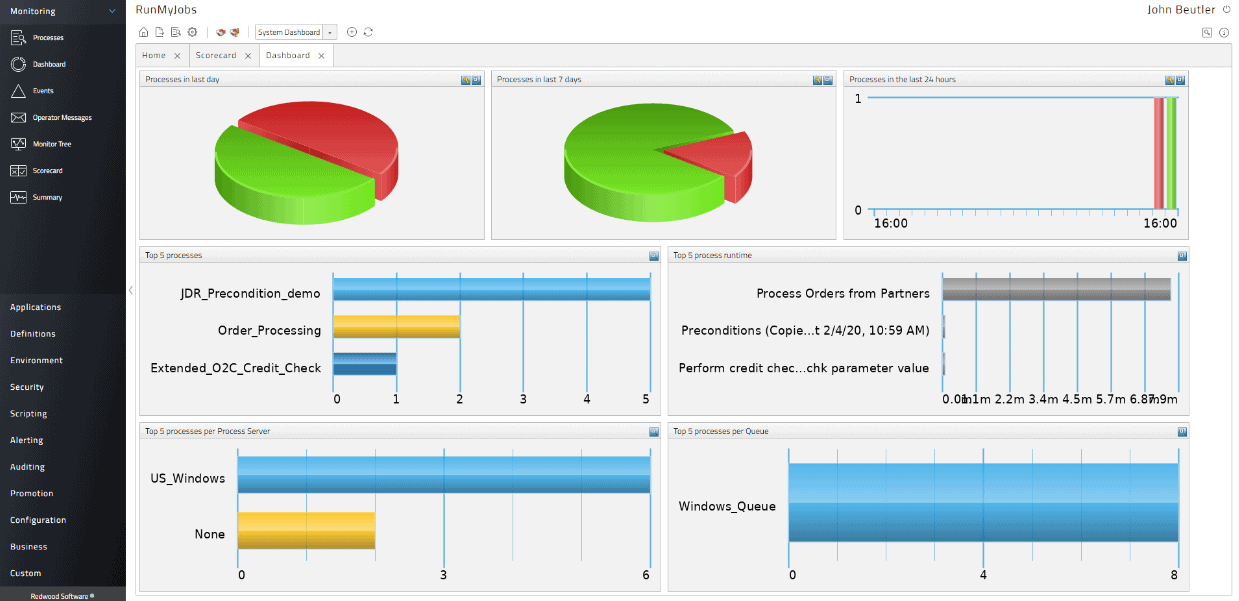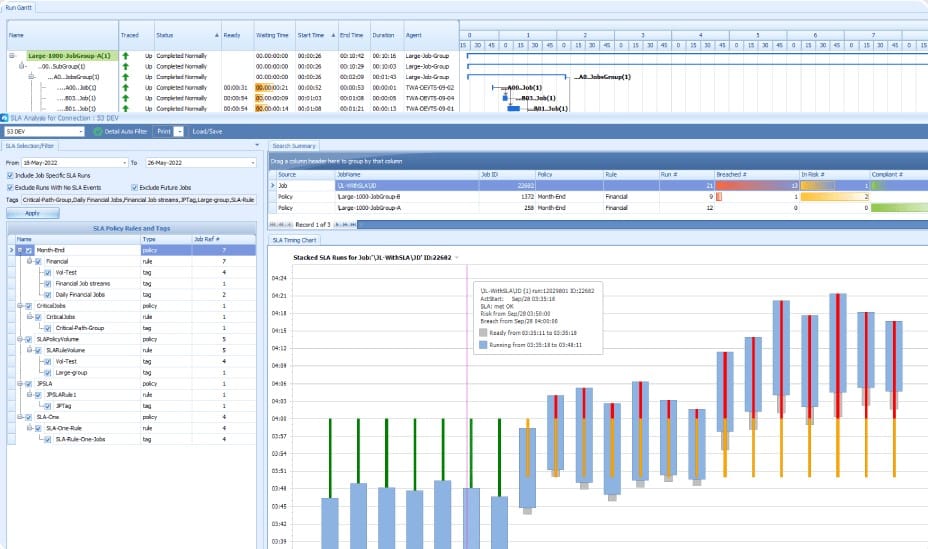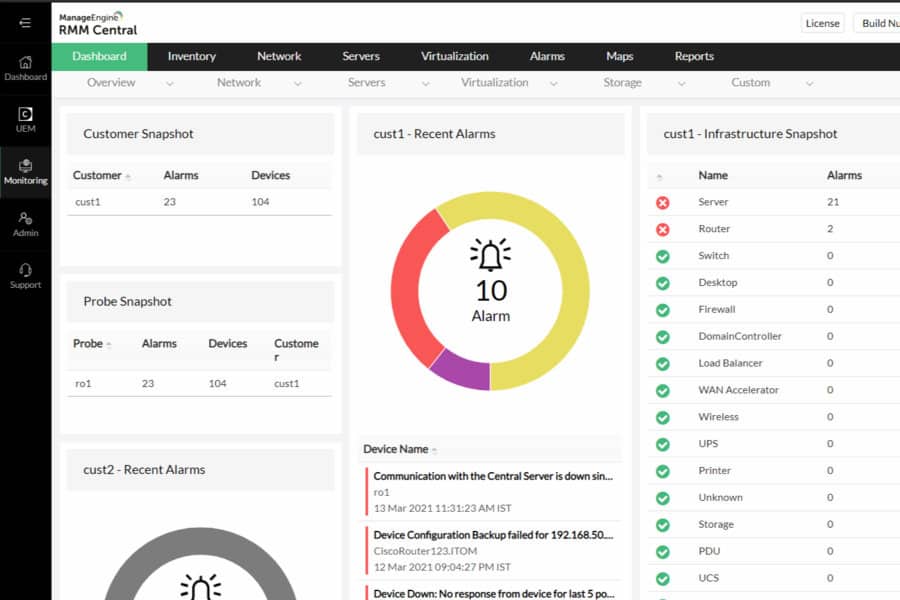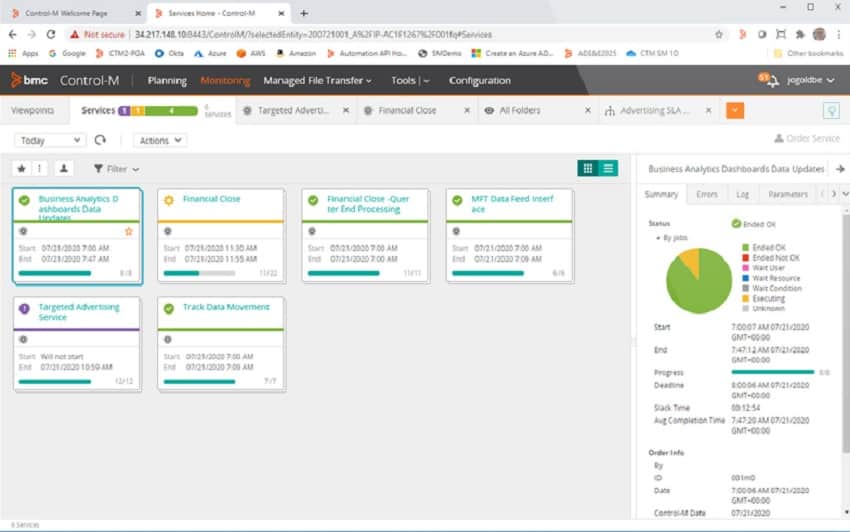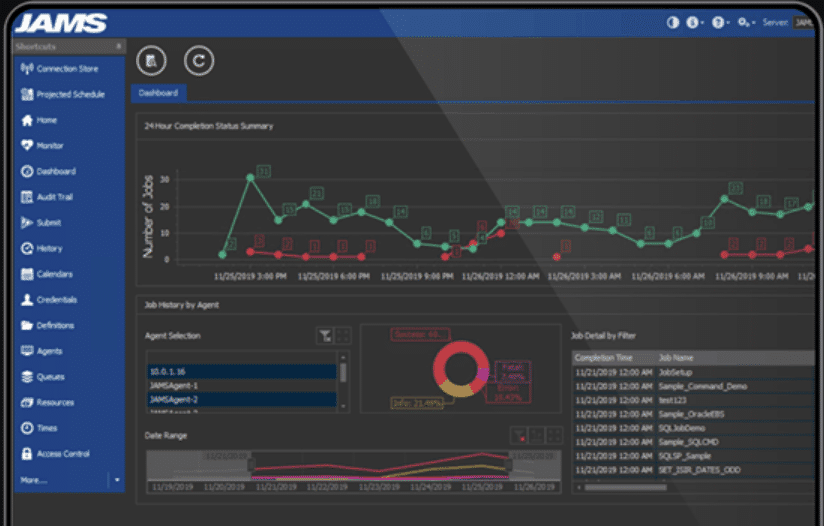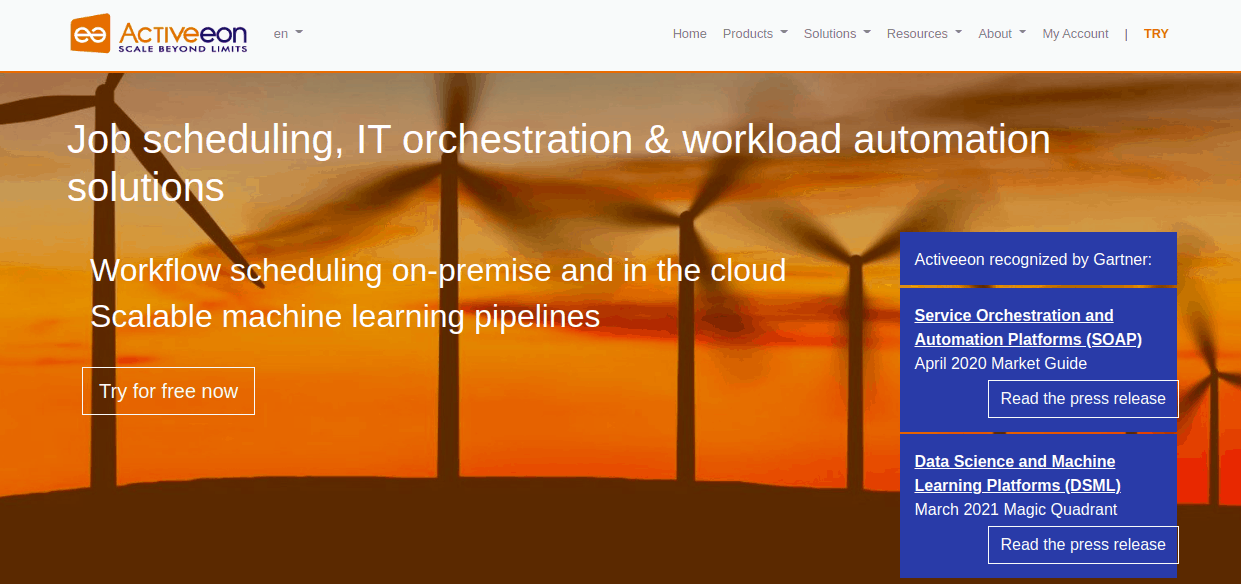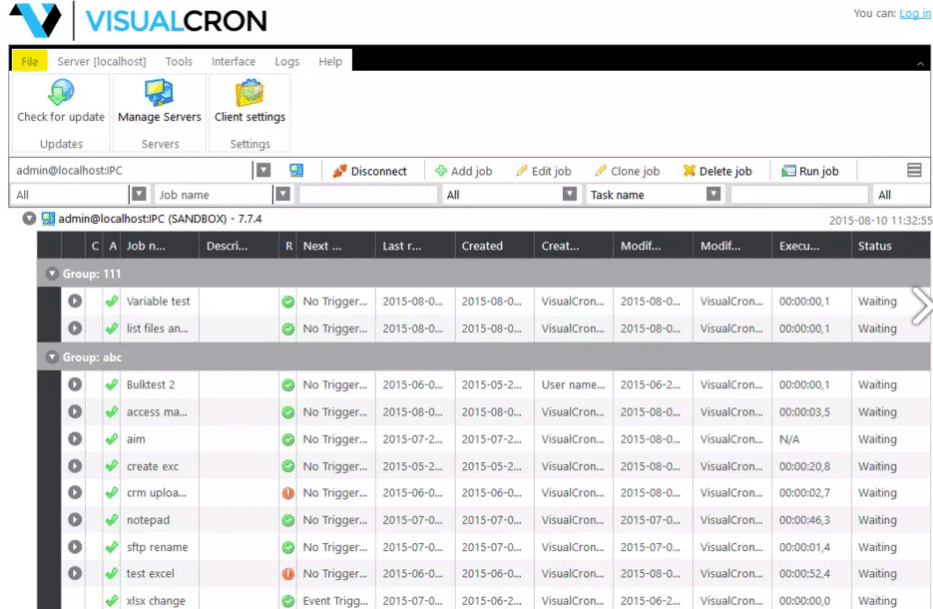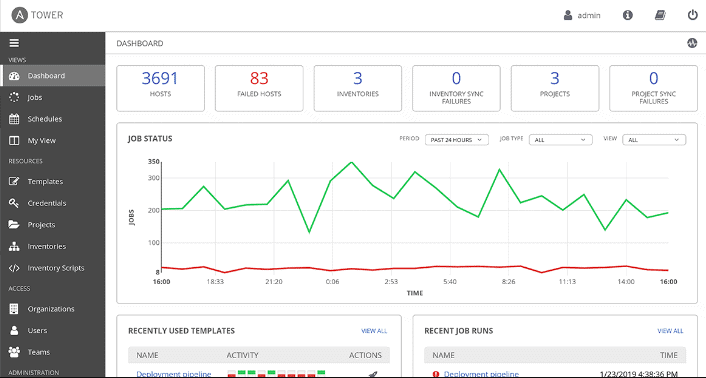Our funding comes from our readers, and we may earn a commission if you make a purchase through the links on our website.
The Best Batch Scheduling Tools
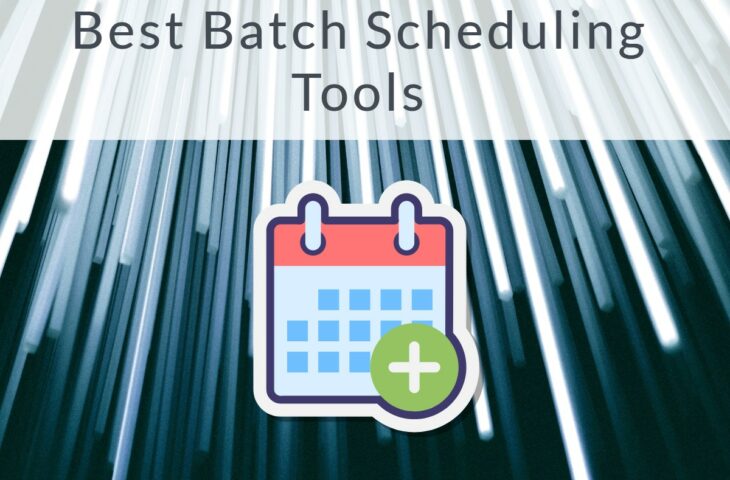
UPDATED: October 26, 2023
Batch scheduling is a part of the background framework of several applications in your daily life. It works towards bettering the user experience and allowing IT staffers to work on ingenious sectors. For businesses, especially large-scale, that have a good number of employees – job scheduling is highly important. Batch scheduling software helps in automating IT processes that function in processing periods which are called batch windows – they can facilitate simple and complex workflows.
The batch schedule software is generally activated during overnight processes so as not to interrupt the workload during the day. Batch scheduling was initially meant for homogeneous mainframes but can now be used for many more specific systems and platforms, with a myriad of functions to choose from.
Here is our list of the best Batch Scheduling tools:
- ActiveBatch – EDITOR'S CHOICE This batch scheduling system works with third-party software to create a chain of processes to manage data flows through an organization. This SaaS package can manage software on any platform, including the cloud and you can assess it through a demo and then a free trial.
- Redwood – GET DEMO A sophisticated cloud-based interface that includes editable workflow templates that feed through to processes definition screens to assemble batch files. These files are launched through the platform, interfacing to all of your systems.
- Tidal Workload Automation – GET DEMO This package enables users to create a process flow batch that launches third-party software and manages data transfers between them.
- Atera – FREE TRIAL A system to support managed service providers that includes a platform of scripts to implement automated system maintenance tasks. This is a SaaS platform.
- ManageEngine RMM Central – FREE TRIAL A tool IT professionals use to monitor and manage their network and devices remotely.
- BMC Control-M A job scheduler that is particularly good for managing DevOps pipelines and running unattended system maintenance tasks. This is a cloud platform.
- JAMS Scheduler A cloud-based scheduling system that enables applications and services to be linked together to perform processes, which are then triggered so that they can operate unattended.
- ConnectWise Automate A cloud-based remote monitoring and management platform that includes automated task allocation and goal tracking as well as scripts to implement maintenance tasks on client systems.
- Activeeon A cloud-based library of APIs that can be called upon from any system to assemble batch jobs that automate processing workflows.
- VisualCron A time-based scheduler that adds a GUI front end to the well-known Cron command line task launcher.
- Turbonomic Application Resource Management Software-as-a-Service that runs in the cloud and interacts with other cloud platforms plus on-site physical and virtual resources to launch batch jobs.
- Ansible A product as Red Hat that specializes in security data gathering around a network. Runs on Linux.
The main purpose of batch scheduling is to help developers, operators, and other IT staffers to get time to use their skills and knowledge on other more important business-oriented ordeals. Tasks such as sharing data, automated batch jobs, and complex needs in widespread systems and applications within an enterprise can be shared between the IT developers and the batch scheduling software.
To manually administer tasks and monitor the workload divided into particular jobs takes a majority of time and resourcefulness out of skilled IT staffers. It poses as a manual constraint for ingenious and knowledgeable people to invest so much hands-on effort on things that simple software can do.
Batch scheduling, therefore, is highly necessary to facilitate specific works to process large jobs and ensure that everything occurs seamlessly for the business to be successful.
In today's fast-paced world, it has become important to make sure that every second in your business is utilized ingeniously.
When the workload is less and IT staffers are not actively working – the batch scheduling software can run overnight to ensure secure transfer and proper storage of data, manage IT infrastructure and IT operations. This guide will help you understand more about Batch Scheduling and its uses, as well as the Top 11 Batch Scheduling Software.
Why Do We Need Batch Scheduling Software?
For IT staffers to be included in more business-critical tasks and spend less time on job scheduling processes, this software has proven to be of great help. There are many reasons as to how business owners can benefit from Batch Scheduling software.
Here is a basic look into what you can gain out of investing in batch scheduling software:
- Opens several possibilities Find the solution to numerous problems at this one-stop. Batch scheduling helps developers and operators create one workflow – be it simple or complex – that can have all the data monitored and managed. It increases efficiency by reducing the number of people required to watch over one element of the business with its grips on several other aspects. Auditing, archiving, and data backup are all some of the many processes that take place with the help of batch scheduling software.
- Increases reliability With this software, all the process involved in batch scheduling is omitted of manual work. Manual work, despite how keen and detailed, can sometimes miss one or two important points. With batch scheduling software, developers can create a framework that will produce the same processes and give you a reliable infrastructure. The single stop to analyze all the reports to find errors and discrepancies can become much easier for IT staffers. By seeing any oncoming problems, batch scheduling avails the opportunity to deal with those problems firsthand without letting it cause imminent harm to the workflow – it eventually helps in saving time, increases efficiency, and helps in enabling reliable automated processes.
- Gives stable results The batch scheduling software works on continuous integration in the background to not interrupt the real-time usage of devices and other departments. Batch schedule software offers solutions that are highly stable and give good customer support. It has also simplified integration and scheduling across varying products, which has helped in reducing silos. All the critical processes related to the business can be managed and monitored under one roof; this helps in keeping the workflow, and data transmission, stable.
- Saves times and money As the saying goes, ‘Time is Money,' nothing is more true than when it comes to businesses. Every second is precious and has the potential to be invested in something beneficial for the business. Therefore, even when the employees are not actively working, batch scheduling software runs overnight and makes sure that the automated processes work according to the solution they have been fed – and indulge in secure data transfer concerning the upholding of the IT infrastructure. Instead of appointing IT staffers who would have to use their knowledge on manual work instead of something business-oriented, you can invest in batch scheduling software that contributes to the company's exponential growth. Moreover, it also helps in centralizing the business while doubling the work by increasing efficiency – as the workload is divided properly.
Benefits of Batch Scheduling System
Knowing why you need Batch Scheduling software, it is now necessary to know of its other benefits that may not be exactly what your business is looking for – but you, as a business owner, will be glad to have found them.
- After-hour work The best thing about a batch scheduling system is that you can set it to process during any time of the day. This feature is used by businesses to especially begin the batch schedule processes overnight when all the workers have left the workplace. Due to this, several other benefits can be extracted. It can help allow the employees to work during the day, without any computers being occupied for job scheduling and other such tasks. It will reduce the time consumption that would take place had the batch scheduling been done manually. After-hour batch scheduling also takes out a chunk of processing costs that would fall on the financial infrastructure. With the availability of computers during the day and the omission of on-call technical staff being used for lengthy jobs, the overall efficiency of your business is increased.
- Cut major costs One of the biggest spending aspects for businesses goes down as the miscellaneous category. And in that miscellaneous also comes the cost of hiring on-call technicians, paying your IT staffers, and not getting the business-critical work done because they are involved with manual work, spending on processing costs. With batch scheduling software, you have a one-time investment that will benefit your business as you have to keep a computer with basic hardware and this software to help you with job scheduling.
- Accommodating all-scale businesses Because of how large-scale batch scheduling may seem, it is assumed that it only fits big businesses. However, batch scheduling software is also extremely helpful to small-scale businesses that have a lot on their hands to increase the visibility of their business. They cannot afford to spend time or money on manually scheduling jobs and other manual IT processes.
- Increases efficiency Manage your staff without worries about the data transfer, job scheduling, backup of information – and other daily IT processes. The automated processes availed by batch scheduling decrease the need to involve hands-on effort from valuable IT staffers and do most of the simple hardware computer after hours. This helps in increasing the overall efficiency of your business concerning cutting costs and prioritizing workflow.
Top Batch Scheduling Tools
Our methodology for selecting batch scheduling tools
- We reviewed various batch scheduling tools and analyzed the options based on the following criteria:
- Support for enterprise environments
- Automation and scheduling capabilities
- Ability to monitor job success and status
- Graphical interpretation of data, such as charts and graphs
- A free trial period, a demo, or a money-back guarantee for no-risk assessment
- A good price that reflects value for money when compared to the functions offered
After understanding why you need batch scheduling software and its benefits, it is time to know which batch scheduling tool will prove to be the perfect fit for you. This guide will give you an overall impression of the tools that we think are highly ingenious:
1. ActiveBatch – GET DEMO
ActiveBatch is one of the most sought-after and popular batch scheduling tools. It offers high performance and greater levels of efficiency. ActiveBatch helps in automated processes, managing dependencies, and transferring data securely. Across heterogeneous frameworks, you can create cross-platform workflows which help you to accommodate and manage data. Without the need to develop your script, you can use the Job Steps in the Integrated Jobs Library of ActiveBatch – and develop ingenious workflows which can help in increasing the efficiency of the employees in your business.
Key Features:
- Comes with interval-based scheduling with custom alerts.
- Avails easy integration of any app with an API.
- Features Machine Resource Optimization, which increases the scalability of machine resources.
- Provides analytic reports on dozens of role-based views.
- Comes with a Machine Load View that has visual heat maps and refined performance graphs which indicated the level of usage and availability of systems.
Pros:
- Operates in the cloud – great for growing or scaling tasks quickly
- Easy to build workflows
- Highly customizable (Great for both complicated and simple tasks)
- Supports both on-premise and cloud task automation
Cons:
- ActiveBatch is designed for network professionals and may take time to fully explore all options
You can get a demo of ActiveBatch and try it out for free for 30 days.
Website Link: advsyscon.com/en-us/lp/ex4/u/batch-scheduling-software
EDITOR'S CHOICE
ActiveBatch gets our vote for the top bach scheduling tool on the market because it cuts costs and improves the quality of your office processes. This is a SaaS package, so you don’t need to find server space for it or keep the software up to date. You also save money on staff because a data processing batch job created by ActiveBatch can replace a team of clerks. The tool can run tasks in bulk out of office hours, working through the night at high speeds and completing all of your data verification and transformation tasks without the errors that can be introduced by human involvement. Get your data processed efficiently and without prejudice with consistent and prompt treatment for every user and client.
Download: Get FREE Demo & Trial
Official Site: https://www.advsyscon.com/en-us/demo/quick
OS: Cloud-based
2. Redwood – GET DEMO
Redwood is a SaaS-based software, which mainly focuses on job scheduling and automation processes. It creates reusable automation and has low-code wizards. This tool offers templates for automating the processes, which saves a lot of time for developers. It comes with a drag-and-drop UI.
Key Features:
- Tracks execution location, taking account of local working hours and holidays to avoid running batch jobs during office hours.
- SAP certified integrations with RISE, with SAP S/4HANA Cloud
- Raises alerts if batch steps fail.
- Records execution performance metrics and termination statuses
- SLA tracking
- Live progress monitoring
- Manages unattended repetitive tasks
Overall, Redwood Workload Automation is a SaaS platform so you don’t need to host it on your own servers. The system is very easy to use with a graphical interface in which you create a process flow diagram, which represents the outline of the batch job. You can place process branches in parallel to offer alternative sequences. Each step in the diagram needs to be specified in detail to name the program that it should launch. The tool generates a script from the diagram and that batch can be set to launch on an event trigger or a time schedule.
Pros:
- Easy-to-use interface
- Can integrate with ERP systems (great for enterprise use)
- Sysadmins can implement traffic shaping to prioritize tasks
- Offers execution monitoring – ideal for complex workflows
Cons:
- Not the best fit for non-technical users
Free Demo Link: https://www.redwood.com/lp/ex0/batch-scheduling
3. Tidal Workload Automation – GET DEMO
Tidal Workload Automation is a batch scheduling tool that can launch batches on a triggering event or on a calendar. The system enables users to string together third-party software packages that ordinarily are not able to work in concert. This creates a process flow and Tidal passes data from one stage to the next.
Key Features:
- Replaces manual data processing
- Can transfer data to other locations and laugh software on different platforms
- Useful for processing data in and out of ERPs
Pros:
- Provides data validation
- Can create complicated process flows with conditional branching
- Multiple uses, such as software pipeline automation and financial reconciliation
- Launches each software package and directs its execution in a macro-like process
- Good for compliance enforcement and SLA tracking
Cons:
- No free trial
Price: Tidal Software doesn’t publish a price list. The best way to investigate this system is to access a demo.
Website Link: https://www.tidalsoftware.com/workload-automation/tidal-automation/
4. Atera – FREE TRIAL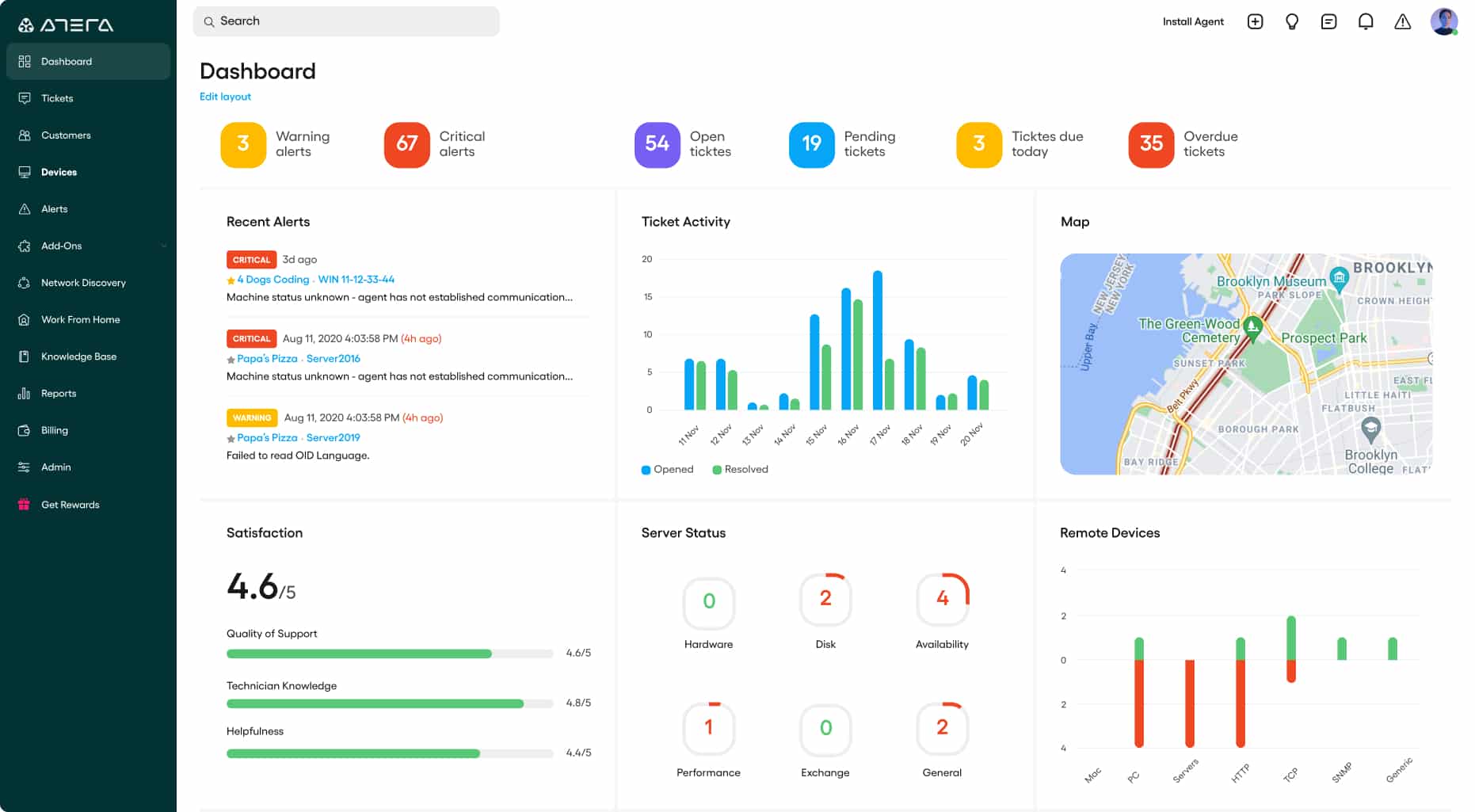
This tool is one of the best batch-scheduling tools for automation and scripting. With Atera, you can create a set of rules that will allow your device – computer – to perform the same process repeatedly with stability and reliability. You can automate several processes that could take up a lot of manual time and disallow IT staffers to work on business-critical jobs.
Key Features:
- Allows you to streamline your services and work.
- Maintains the controlled interactions that take place between your client's workstation and the client.
- Features robust scripting tool to increase the efficiency of the automation process.
Pros:
- Lightweight cloud-based tool
- Built with MSPs in mind, and includes RMM and PSA tools built-in
- The framework is highly customizable, making Atera extremely flexible
- Can scale and support multiple databases in a multi-tenant environment
- Packaged pricing makes Atera accessible to any size business
Cons:
- Atera is MSP focused, smaller organizations may not use all multi-tenant features
Price: The pro package starts at $99/month on the annual pricing plan. You can get access to a 30-day free trial.
Website Link: https://www.atera.com/remote-monitoring-and-management/it-automation-and-scripting/
5. ManageEngine RMM Central – FREE TRIAL
ManageEngine RMM is a tool IT professionals use to monitor and manage their network and devices remotely. It includes features such as remote access, patch management, asset management, and more. With RMM, IT professionals can proactively monitor their network and quickly respond to any issues that arise, improving the overall efficiency and reliability of their IT infrastructure.
Key Features:
- Remote access: Allows IT professionals to remotely access and control devices on their network.
- Patch management: Automates software updates and patches to keep devices up-to-date and secure.
- Asset management: Provides a comprehensive inventory of all devices on the network, including hardware and software details.
- Monitoring: Continuously monitors the network and devices for issues, such as high CPU usage or low disk space, and sends alerts when problems are detected.
- Reporting: Generates reports on the health and performance of the network and devices, providing valuable insights and enabling proactive maintenance.
Pros:
- Features a suite of automated and manual monitoring tools for various helpdesk needs
- It can be installed on both Windows and Linux platforms, making it more flexible than other on-premise options
- Offers in-depth reporting, ideal for enterprise management or MSPs
- Intuitive interface and sleek admin dashboards – great for NOC teams
Cons:
- ManageEngine provides a suite of monitoring tools that can take time to learn and understand fully
Website Link: https://www.manageengine.com/remote-monitoring-management/
6. BMC Control-M
This tool is best for automated processes of big data workflows. With Control-M by BMC, you can get help with job scheduling and workload automation. Control-M also avails other functions like arranging, automating, and integrating application workflows. The self-service extension of Control-M allows you to indulge in batch scheduling on mobile devices as well – it offers more solutions.
Key Features:
- Deployment of Control-M can be done in the cloud, on-premises, or even in a hybrid environment.
- Its workflow arrangement can be embedded into your CI/CD pipeline.
- Native integrations allow automation of big data workflows.
- Agile delivery practices increase the application delivery speed.
Pros:
- Highly customizable tasks, dashboard, and scheduling features
- Supports multiple operating systems such as Linux, Windows, and macOS
- Uses a simple yet informative dashboard for monitoring
Cons:
- Would like to see more workflow visualization options
- Not the best fit for non-technical users
Website Link: https://www.bmc.com/it-solutions/job-scheduling-workload-automation.html
7. JAMS Scheduler
For cross-platform scheduling, JAMS Scheduler offers one of the best capabilities and features. It is a robust tool that can help you in running precise batch processes. With this tool, you can monitor, orchestrate, and log every action to manage it. JAMS Scheduler helps you with innumerable associated jobs and file dependencies. It has powerful features that can help in revitalizing batch processing.
Key Features:
- Lets you integrate complex processes over numerous applications and platforms.
- Requires one central schedule for whichever batch process you are involved with.
- Allows you to check on prior job definitions, make changes in them and also retain them.
Pros:
- Excellent workflow and data visualizations
- Easy to track assets across multiple workflows
- Designed with enterprises in mind (ERP support, etc)
Cons:
- Smaller organizations might not benefit from all of JAM Schedulers' options
Website Link: https://www.jamsscheduler.com/solutions/batch-processing/
8. ConnectWise Automate 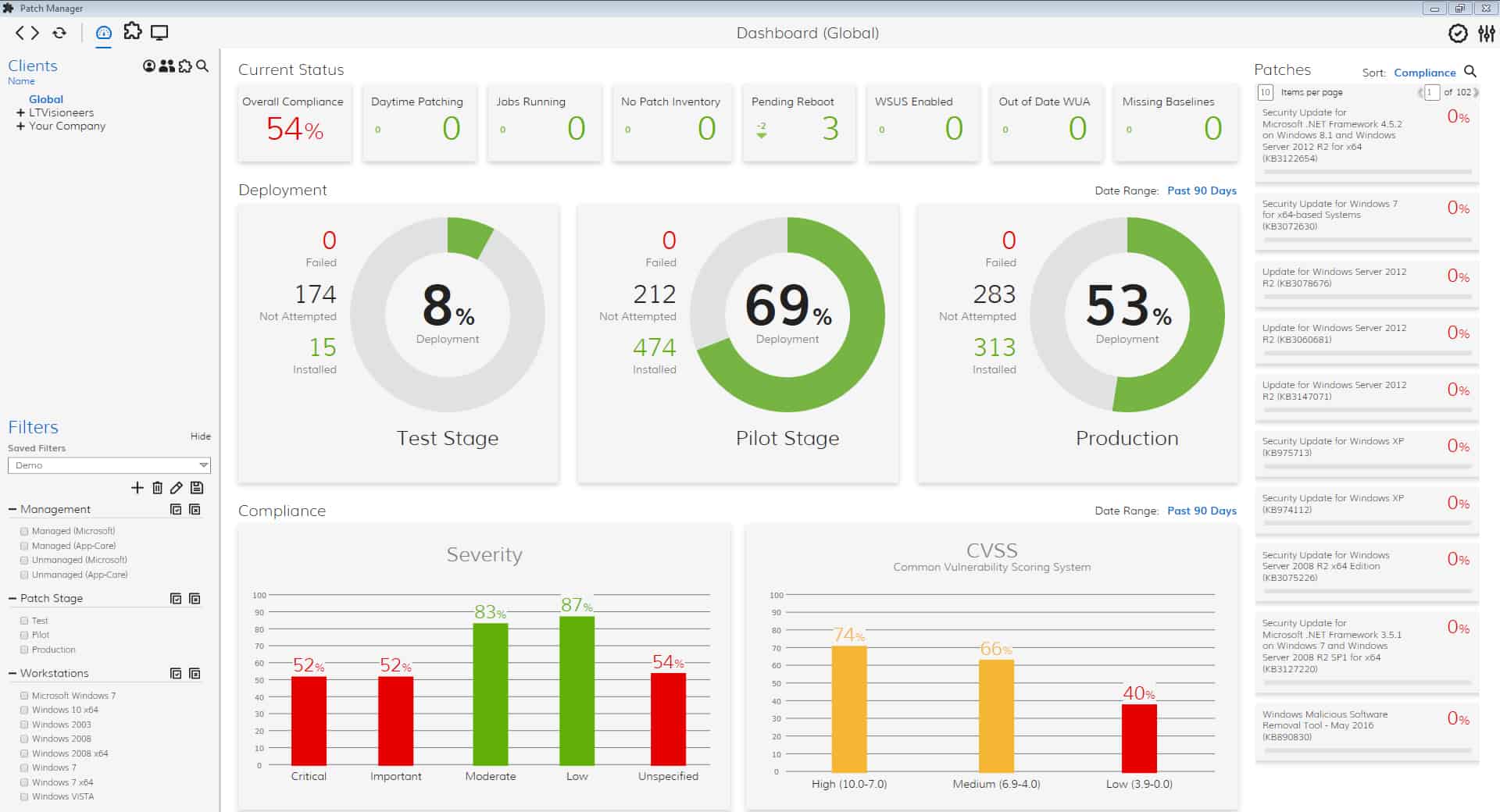
ConnectWise Automate, as its name suggests, works best for automating simple to complex tasks. It helps in taking the majority of the workload that would require a lot of manual work from ingenious IT staffers or on-call technicians getting paid out of your pocket. This tool helps streamline server and desktop management and offers features that include automated time entries.
Key Features
- It comes with an RMM solution that gives you control over systems – agent or agentless.
- You can get access to endpoint devices through ConnectWise, without interrupting other active systems.
- It handles multiple platforms, offers self-service options to end-users, and indulges in proactive maintenance.
Pros:
- Can help NOC teams automate repetitive tasks
- Integrates well into the ConnectWise ecosystem with tools such as ConnectWise Control
- Can be used as an all-in-one tool for RMM, inventory management, and PSA
- Best suited for large enterprises and MSP environments
Cons:
- Designed for larger networks and multi-tenant use – not the best option for small networks
Website Link: https://www.connectwise.com/software/automate/it-automation
9. Activeeon
For multi-cloud and hybrid environments, Activeeon will be one of the best Batch Scheduling tools for you. It offers a myriad of features that help you with the migration and synchronization of data. Adding to this, Activeeon also helps optimize the resourcefulness of all the available resources in your system.
Key Features:
- It offers great scalability and a big pool of dynamic resources.
- Activeeon can be integrated with pre-existing data sources in your device.
- The workflow interface is user-friendly and not complex.
- It allows you to monitor the utilization and execution of resources.
- Activeeon provides fast results, with high-performance efficiency.
Pros:
- Supports customs workflow builds that allow you to build off templates
- Offer numerous notification options
- Can automatically assign workflows to new devices without configuration
Cons:
- More complex automation features might be too much for smaller organizations
Website Link: https://www.activeeon.com/solutions/batch-scheduling/
10. VisualCron
When you can handle multiple platforms with a single central console, most of your IT-related concerns get solved. There are around 300 custom tasks that omit on-call technicians or IT staffers to be indulged in manual work that can be easily and efficiently done through software. VisualCron is, in its element, a customer-driven development and has solutions following it.
Key Features:
- Finds incomplete tasks and automatically deletes them.
- Mainly provides options for event-driven scheduling.
- Provides notifications of errors to be able to handle the processing better.
- Avails architecture for triggers, tasks, and connections.
Pros:
- Generous 45-day trial
- Easy to use drag and drop workflow builder
- Highly flexible platform
- Primarily uses time-based scheduling
Cons:
- Best suited for smaller workflow – not ideal for enterprise use
Website Link: https://www.visualcron.com/Job-Scheduling-Software.aspx
11. Turbonomic Application Resource Management 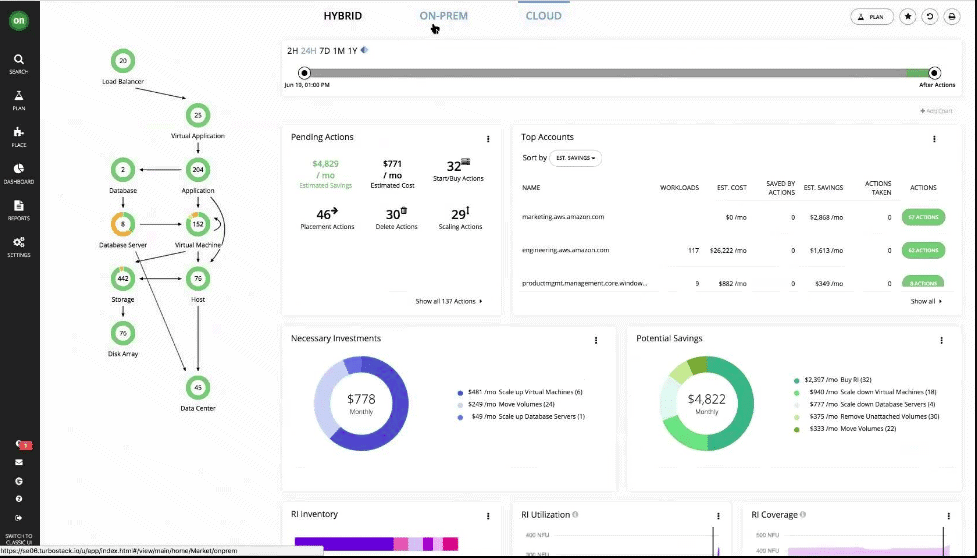
For application resource management, this tool proves to be one of the best. It gives you a visual of the impact of infrastructural changes on the performance of data warehouses. Turbonomic has great cloud management features, along with network, on-premises, cloud, and application; it's a package of resourcefulness. With the AI-powered software, you can optimize application compliance, performance, and cost – that too, in real-time.
Key Features:
- Starting from apps to hardware, it understands the complete stack.
- You can thoroughly understand the aspect of performance risk with Turbonomic.
- Cloud-based system avails data transfer, migration, and other processes for clients in real-time.
- Simple one-click execution of workflows.
Pros:
- Cloud-based tool (Highly flexible)
- Leverages autodiscovery to enroll new devices into automated workflows
- Compatible with major virtualization platforms such as VMWare, Hyper-V, and XenServer
Cons:
- Some features such as automated remediation can be complex for non-technical users
- Would like to see more visualization options
Website Link: https://turbonomic.com/product/
12. Ansible
Not everyone can use complex batch scheduling tools, especially those meant exclusively for large-scale businesses. Therefore, a much simpler software with an easy user interface is the Ansible batch scheduling tool that avails agentless IT automation that anyone can use. You don't need to know coding to use this tool – but that does not mean that it offers little to no support for your IT infrastructure.
Key Features:
- Solves problems at once and then shares them with all.
- Offers features for automated inventory management, job scheduling, automated execution that is centralized, and others as such.
- Automates deployment of management of systems and apps.
Pros:
- Simple minimalistic interface – makes it easy to view key metrics
- Leverages playbooks to automate device configuration and deployments
- Supports numerous vendors, with plenty of community-built template
- Completely open source and free
Cons:
- Is a full-service monitoring platform that can take time to fully explore all options available
- Open source tool that might not be the best fit for all network environments
Website Link: https://www.ansible.com/
Final Thoughts!
This guide lets you understand the basic impression that the Top 11 Batch Scheduling software, according to our research, entails. According to the information provided above, it depends on you to research the tool you think would suit your needs best. Batch Schedule Software will help your business immensely regarding job scheduling, automating processes, secure transfer of data, and much more. It will all eventually help your business's success and give time to your IT staffers to be indulged in business-critical work.
Batch Scheduling Tools FAQs
What are the features of batch scheduling tools?
The features of batch scheduling tools can vary, but some common features include job scheduling, job dependency management, job monitoring, alerting and notification, workload balancing, and reporting.
What is job scheduling in a batch scheduling tool?
Job scheduling is the process of defining when and how often a batch job should run. A batch scheduling tool allows users to specify the start time, end time, frequency, and other parameters for each job.
What is job dependency management in a batch scheduling tool?
Job dependency management is the process of defining the relationships between different batch jobs. A batch scheduling tool can ensure that jobs are executed in the correct order, with dependencies between jobs enforced.
What is job monitoring in a batch scheduling tool?
Job monitoring is the process of monitoring the progress and status of batch jobs. A batch scheduling tool can provide real-time updates on job status, and can trigger alerts or notifications if a job fails or encounters an error.
What is workload balancing in a batch scheduling tool?
Workload balancing is the process of distributing batch jobs across different systems or servers to improve performance and efficiency. A batch scheduling tool can balance workload by automatically routing jobs to the most available or suitable systems.
What are the benefits of using batch scheduling tools?
The benefits of using batch scheduling tools include improved efficiency, reduced errors, improved scheduling accuracy, reduced labor costs, improved compliance, and improved job management and monitoring.

